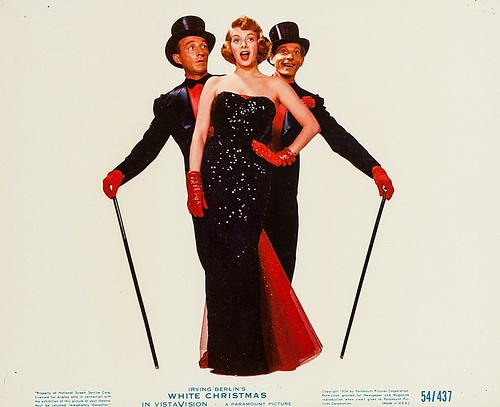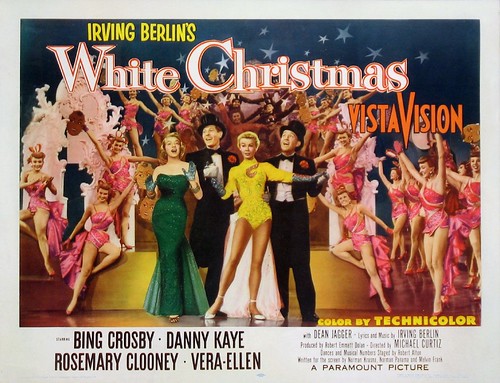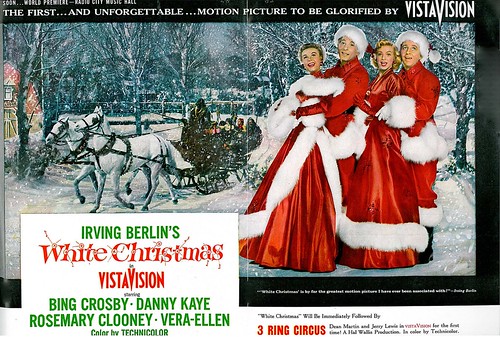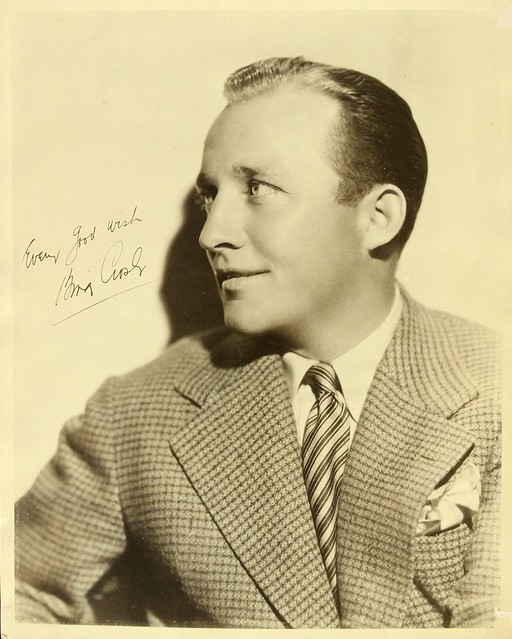WHAT: White Christmas (1954, DCP)
WHEN: Sunday, December 11, 2022 1 PM
WHERE: Pickwick Theatre, Park Ridge, IL
WHAT ELSE: Pre-show music at 12:30 PM by Jake McDonagh
HOW MUCH: All seats $10! Click Here!
Join us this December for a two-day Christmas spectacular at the Pickwick Theatre! We will have our first Sunday screening when we present White Christmas (1954) on December 11, 2022, at 1 PM. The last time we played this holiday classic (in 2017), we had over 800 patrons in attendance, so come early. Doors will open at noon!
Two song and dance men, Wallace & Davis (Bing Crosby, Danny Kaye), team up with a sister act (Rosemary Clooney, Vera-Ellen) to help out a retired Army general and bring some business to his struggling Vermont inn. White Christmas (1954) features an Irving Berlin score that includes such songs as “Sisters,” “Snow,” “Count Your Blessings (Instead of Sheep),” “Love, You Didn’t Do Right By Me,” and the unforgettable title song which Berlin had written in 1940. Directed by the legendary Michael Curtiz (his first film away from Warner Bros.), White Christmas remains one of the most popular of all holiday classics and is perhaps Bing Crosby’s best known film to modern audiences.
Originally, White Christmas was to re-team Bing with Fred Astaire, his co-star from Holiday Inn (1942). Though the film would have greatly benefitted from Astaire’s presence, it’s understandable why he turned it down; the part was the kind of ‘second banana’ role Astaire might’ve played fifteen years earlier. Donald O’Connor was sought out next, and this would’ve been a wonderful casting decision, but he fell ill and was replaced by Danny Kaye, who himself was a big star at the time. Kaye was a slapstick comic known for his mimicry, but he could also sing and dance. However, a little of Danny Kaye goes a long way. (I don’t think too many remember his “Choreography” number as one of the film’s great highlights.) But fortunately, this is Bing’s film from start to finish, and Kaye ably supports him as the sidekick.
Bing Crosby was one of the most original and influential entertainers in American culture. He was a star of radio, film, and later, television. In 1954, he was a major figure on the Paramount lot. In fact, he had been the #1 box office star for five consecutive years (1944-1948). Bing’s films were guaranteed box office, most notably the “Road” pictures he made with Bob Hope– the highest-grossing comedies at that time. Bing Crosby remains one of the most important musical artists of the 20th century, and he has become identified with Christmas through his many holiday albums. “White Christmas” is his signature song, and in many ways, the 1954 movie version of it is his signature movie. In an age where pop stars come and go, Bing Crosby’s lasting impact on our culture continues to shine. For more about Bing’s remarkable career, the definitive biography is Bing Crosby: A Pocketful of Dreams (2001) by Gary Giddens.
Rosemary Clooney could sing but couldn’t dance. Vera-Ellen could dance but couldn’t sing (her voice was dubbed). But with six weeks of rehearsal time, both actresses appear flawless in their performances. Together, they make a terrific pair as the sister act Bing and Danny meet up with. Clooney’s duets with Bing are some of the most enjoyable moments in the film. In addition to her singing talents, Clooney benefited from the Edith Head costume designs, particularly the black velvet dress she wears during “Love, You Didn’t Do Right By Me.”
Bing’s songs are always the highlight, but having seen White Christmas recently, I was struck by another element that gives the film its resonance. It’s the military aspect personified by Dean Jagger’s character, a former general now running a country resort in Vermont. I don’t want to give anything away for those who haven’t seen the film, but those final moments with Jagger are terrific. He is the one who gives this sometimes contrived plot about misunderstandings its heart. Jagger, who had starred in films like Twelve O’Clock High (for which he won an Oscar as Best Supporting Actor), is mostly overlooked when people talk about White Christmas, but without him, the film wouldn’t have the emotional weight it carries.
The success of the 1954 film inspired a Broadway stage musical that packed even more songs into the plot. The continued popularity of White Christmas shows no signs of diminishing. In households across the country, it’s must-see viewing at Christmastime. Part of the attraction of the film– in particular the title song– is the nostalgia it evokes. “White Christmas” is a longing for home and family. This is clearly seen on the faces of the soldiers in Italy on Christmas Eve when Bob Wallace sings to the troops. It’s not just the white Christmas they miss, but all those feelings connected with being at home for the holidays. It’s interesting that the song is sung twice in the film– but in two different contexts. The aforementioned longing for home in the opening scenes is bookended by a more literal wish for snow and a white Christmas in Vermont. The greatness of Irving Berlin’s “White Christmas” is that it’s one of those perfect songs that builds a sense of community; the spirit of the song and what it embodies has become ingrained in our national identity.
“Snow”– one of the film’s most memorable numbers.
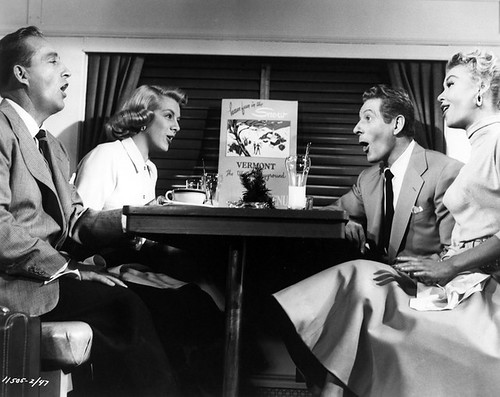
White Christmas is a very different film when you’re not watching it on a television. We will be screening a digital restoration which should look spectacular on our big screen. At the time of its release, the film was the first to use the “VistaVision” widescreen process. This was a high resolution 35mm format that took full advantage of the screen in terms of its maximum height and width– from a 1:33/1 aspect ratio to a 1:85/1. The notes for the film on the TCM website elaborate on VistaVision: “According to an October 1953 New York Times article, (VistaVision) used single-strip Eastman color film and a new camera with a double, or 70mm, frame. The camera exposed the negative horizontally rather than vertically ‘from magazines specially mounted on the side of the lens.’ The image was then optically printed into a positive 35mm frame and projected in the usual, ‘vertical feed’ fashion. As noted in the Daily Variety review, VistaVision boasted a ‘consistent picture quality in the various wide-screen projection ratios…from the standard 1.33 up to 2 to 1. The quality carries over into 2.55-1 when the VV negative is printed anamorphically for that aspect ratio.'” The result is that audiences saw an image of exceptional clarity.
December 11 will be a memorable afternoon for us when Park Ridge gets a rare opportunity to see this holiday classic theatrically. The annual tradition that so many have shared in their homes can now be experienced with a large, appreciative audience. We cordially invite you, your family, and your neighbors to our “Yuletide clambake.” It’ll be a “slam-bang finish” to 2022, as Bing might’ve said.
~MCH
For some White Christmas trivia, Click Here!

